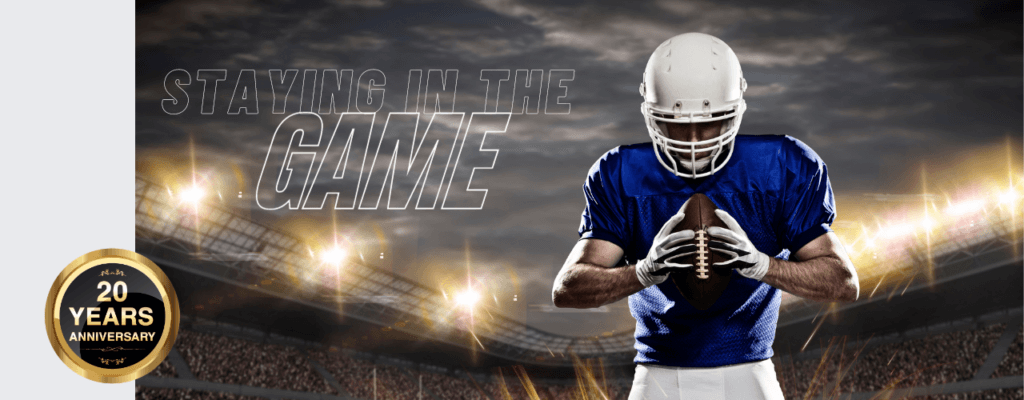Safeguarding Athletes: Tackling Early Injuries for a Successful Football Season
When it comes to staying at the top of their game, elite football players employ effective strategies to prevent sports injuries from hindering their performance. The ultimate objective for athletes is to stay on the field, and this requires taking proactive steps to ensure their well-being.
How do they do this?
Optimal Recovery Strategies for Football Players
Eric Bengtson, DPT, emphasizes the importance of tailoring your recovery routine to your own preferences and schedule. He advises, “Do what works best for you, for your body, personal preference, and what you have time for. Take two of these recovery methods and make them a habit.” It’s widely recognized that relying on just one recovery method may not suffice, while incorporating three might be excessive. Therefore, the key takeaway is to discover the two techniques that suit you best and integrate them into your post-practice routine.
Post-practice recovery is crucial for football players, and there are various methods such as ice/hot baths, foam rolling, biking/stretching, massage guns, and compression pants (NormaTec) to choose from. The key is finding the right combination that works best for you.
Distinguishing Pain from Injury: A Vital Skill in Football
Pain can be a precursor to more severe issues, potentially leading to compensation patterns and repetitive trauma, among other complications. Addressing pain early is crucial because it helps us quickly figure out what’s causing it. Ignoring pain can exacerbate the problem, making it more severe when you play again.
At Houghton Physical Therapy, we understand the significance of timely intervention. That’s why we offer an easy-to-schedule Free Discovery visit, ensuring you can consult with one of our medical professionals as soon as the same day or within hours after sustaining an injury. Whenever you need to discover a solution for your injury or pain, we are here to provide the necessary assistance. In the high-impact world of football, distinguishing between pain and injury is essential. When there’s a loss of function, it serves as a clear signal that an injury may be lurking, highlighting the importance of getting checked out by a medical professional.
“We often treat individuals who have a passion for running or playing football, including those who are part of teams. It’s crucial to these athletes to stay active and on the field. While some may believe in a ‘stay off it’ approach, and others try to tough it out, physical therapy provides a path to healing and assists in keeping you actively engaged in the game.”
Saved by Early Detection:
Eric recalls a young athlete who struggled with persistent ankle pain. After two days of failed recovery attempts, the athlete attempted to return to practice, only to experience more pain. Recognizing the severity of the situation, they scheduled a Discovery visit with our team.
During the visit, following established guidelines, they decided an X-ray was needed. Urgently, the athlete went to an urgent care center for the X-ray.
Surprisingly, the X-ray revealed a small ankle fracture. This early detection prevented a more severe injury and spared the athlete from participating in that Friday’s game. This case served as a clear example that “pushing through” pain can lead to harm, while timely professional evaluation can keep athletes in the game.
Swift Solutions: Healing a Sprained Ankle and Dodging Major Setbacks
Why is it happening?
Are you wondering why a sprained ankle occurs? Often, it’s the result of factors like surface conditions, muscle tightness, or stiffness in the ankle and back, leading to a loss of flexibility. Ligament laxity, reduced stability, and coordination can also contribute. But here’s the good news: with the right approach and swift action, you can overcome a sprained ankle and avoid major setbacks.
What will help?
Balancing Exercises: To expedite your recovery, incorporating balance exercises into your routine can be highly beneficial. These exercises involve contracting and engaging multiple muscles simultaneously, contributing to a faster healing process.
Strapping/Taping: When it comes to strapping for ankle injuries, it’s essential to use caution and consider your specific situation. Generally, strapping should be reserved for cases where it’s necessary, especially in the short term. Prolonged reliance on strapping can lead to limitations over time.
Rest/ R.I.C.E: The concept of rest in injury recovery has evolved over time, with the traditional R.I.C.E. (Rest, Ice, Compression, Elevation) approach becoming somewhat outdated. Today, the newest method suggests a more dynamic and progressive approach to recovery, emphasizing mobility and gradual reintegration rather than extended periods of rest.
P.R.I.C.E was the next generation – (Protection, Rest, Ice, Compression, Elevation)
P.O.L.I.C.E was next – (Protection, Optimal Loading, Ice, Compression, Elevation)
Now research is suggesting – P.E.A.C.E & L.O.V.E (Protection, Elevation, Avoid anti-inflammatories (and sometimes ice), Compression, Education) (Loading, Optimism, Vascularization, Exercise)
Basically – Sitting and waiting for something to heal is not enough.
Protecting Our Players: The Importance of Concussion Testing in Football
Concussion testing plays a pivotal role in safeguarding the well-being of our players, both on and off the field. Whether it occurs at school or a doctor’s office, the significance lies in establishing a baseline understanding of an individual’s cognitive and physical condition.
In cases where recovery from a concussion appears stagnant or doesn’t show improvement within a few days, the need for physical therapy becomes apparent. This additional step is vital because a prolonged recovery might signal underlying issues such as neck restrictions or deficits in pupil focusing and reaction time, all of which require specialized intervention to ensure the athlete’s full recovery.
Parent’s Playbook: Relieving Aching Backs and Hips from Bleacher Sitting
In the span of a football game, lasting approximately 2 to 2.5 hours, your body goes through various changes as you sit in the bleachers, which often lack proper back support. If you’re already experiencing hip or back pain, it’s no surprise that it can intensify during this time.
To help alleviate this discomfort, here are three invaluable tips to consider.
First, consider scheduling a yearly physical therapy check-up with your physical therapist, providing you with a regular maintenance routine for your body.
Second, staying active and moving around during the game can prevent stiffness and discomfort.
Lastly, never ignore pain; addressing it promptly is essential for your well-being and overall enjoyment of the game.
At Houghton Physical Therapy, we’ve been dedicated to helping thousands of individuals break free from pain and rediscover active lives for over 20 years. We’ve assisted star quarterbacks recovering from injuries and young athletes aiming for excellence on the field. We provide the same care and expertise to everyone who walks through our doors.
Other Resources:
Unlock the secrets to recovery that only the pros know and use! Get your FREE downloadable report, “7 Secret Recovery Strategies That Only Pro Athletes Know And Use,” and keep it in your gym bag for quick reference. Don’t miss out on this exclusive offer – Click here to grab your copy now!
Interested in scheduling a FREE Discovery Visit? You can either click here or simply give us a call, and we’ll arrange a visit with one of our exceptional therapists at your convenience.
Don’t forget to explore our YouTube channel, where we’ve amassed over 200 video tips and solutions. Take a look at this one specifically focusing on Children’s Sports Injuries – simply click here.
Here’s another informative video featuring our dedicated owner, Todd Houghton, discussing Concussion Recovery. You can watch it by clicking here: “The Top 5 Tips for Concussion Recovery.”



